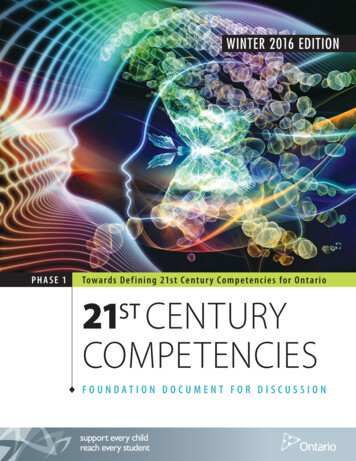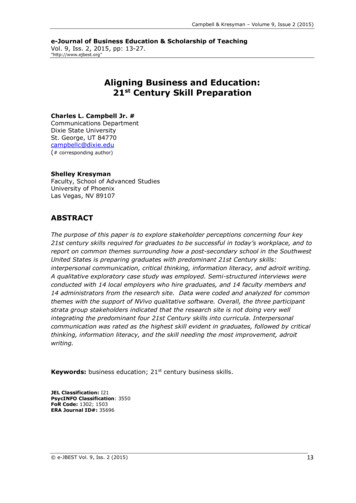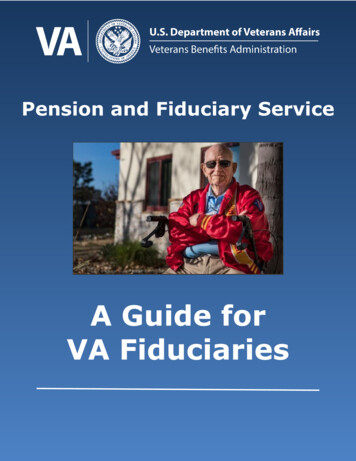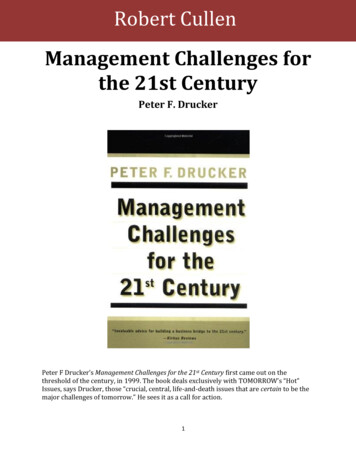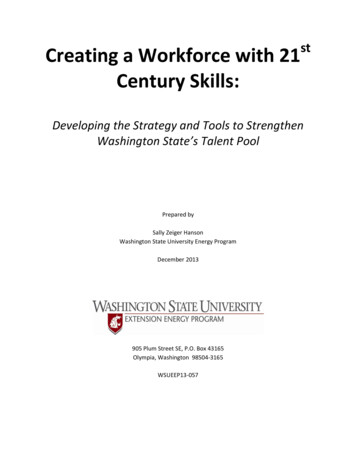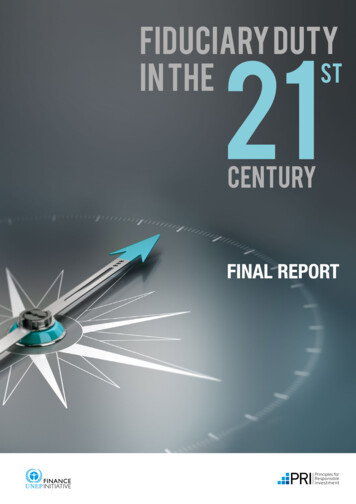
Transcription
FIDUCIARY DUTYSTIN THE21CENTURY
2FIDUCIARY DUTY IN THE 21ST CENTURYABOUT THIS REPORTIn January 2016, the PRI and UNEP FI, with the generous financialsupport of The Generation Foundation, launched a four-year projectto clarify investor obligations and duties (known in commonlaw markets as fiduciary duties) in relation to the integration ofenvironmental, social and governance (ESG) issues in investmentpractice and decision making. The project involved working withinvestors, governments and intergovernmental organisations:The origins of the modern interpretation of fiduciary duty date backto the landmark 2005 Freshfields Report, commissioned by theUnited Nations Environment Programme Finance Initiative (UNEP FI)Asset Management Working Group. Whereas there was relativelylittle change in the law relating to fiduciary duty between 2005 and2015, there has been a great deal of development in the past fewyears.1. To develop and publish an international statement on investorobligations and duties.This report describes how the integration of ESG issues intoinvestment practice and decision making is an increasinglystandard part of the regulatory and legal requirements forinstitutional investors, along with requirements to consider thesustainability-related preferences of their clients and beneficiaries,and to report on how these obligations have been implemented.It also identifies areas where further work is required and reflectson how investors’ duties and obligations may further evolveover time.2. To prepare policy analysis and research into investor dutiesacross a range of markets, published in country roadmaps.3. To engage with policy makers and encourage them to adoptpolicy measures that clarify and formalise that investor dutiesand obligations incorporate ESG issues in their markets.This is the final report from that project. It replaces the original2015 report which found that the “failure to consider all longterm investment value drivers, including ESG issues, is a failure offiduciary duty”. Despite significant progress, many investors werenot fully integrating ESG issues into their investment decisionmaking processes, necessitating regulatory clarification.
FIDUCIARY DUTY IN THE 21ST CENTURY3CONTENTSAbout this report2Forewords4Executive summary8The origins of fiduciary duty10The new policy context13The financial and invesment relevance of ESG issues17The changing landscape of investment practice19Modern fiduciary duty21Next steps22Country analysis24Fiduciary duty in the 21st century programme52Evolution of fiduciary duty54Glossary56Acknowledgements57About the project partners58
4FIDUCIARY DUTY IN THE 21ST CENTURYFOREWORDSBRUNO LE MAIREThe world economy is at a crossroads. While climate risk becomesobvious, and populism is gaining traction in many jurisdictions, theinvolvement of all stakeholders is crucial to shift to an economymore responsible from an environmental and social perspective.The financial system has a crucial role to play in the shift towardsa more sustainable economy – regulators and supervisors cannotact alone. The involvement of the financial sector will be key inchannelling capital and fostering investment decisions: withouta strong signal from investors, insurers, bankers, no significantchange in our economic system will be possible. And it is in theinterest of financial firms to engage in the transition, as climate riskor stranded assets may suddenly disrupt their business models.Bruno Le Maire, Minister of theEconomy and Finance, FranceWe welcome the long-time involvement of the PRI initiative in drivingthis change by gathering an ever-growing number of investors.It was an honour for me to welcome this year’s PRI in Person inParis. France intends to be at the forefront of this challenge, bysetting up a comprehensive regulatory toolbox for the developmentof sustainable finance, while pushing for similar efforts at theEuropean and international level. It is crucial to give corporatesand investors the stability they need to integrate long-termconsiderations into their strategic decisions.In this view, I welcome the latest report of the PRI and UNEP FI“Fiduciary duty in the 21st century” which puts forward in-depthpolicy recommendations. The time has come to take bold actionin order to mitigate climate change according to the temperatureobjectives of the Paris Agreement and to achieve the SDGs by 2030.The dialogue between regulators and stakeholders is of the utmostimportance in order to draft efficient pieces of legislation which fitthe need of all relevant actors. I look forward to working along withyou on overcoming those burning challenges and achieving theurgent transition we cannot postpone any further.
5FIDUCIARY DUTY IN THE 21ST CENTURYBRIAN SCHATZClimate-related financial risks are not just something that willhappen in the distant future: climate change is already increasingthe frequency and severity of severe weather events like droughts,floods, and wildfires, and it will drive changes to long-term climatepatterns that will be economically devastating. Temperatureincreases will lower labor productivity and stress agriculturalyields. Rising sea levels will devalue and destroy coastal properties.Insurance coverage will be prohibitively expensive or simply notavailable.Brian Schatz, United States Senatorfor Hawai’iMarket participants recognize this reality. Investors increasinglyseek opportunities with positive environmental, social, andgovernance attributes precisely because doing so will maximizereturns over the long term. Contrary to the longstanding perceptionin some circles that ESG investing is associated with a “performancepenalty”, we know companies that incorporate sustainability intotheir business models often outperform those that do not. As climatechange impacts every sector of the economy, investors who chooseresponsible investing will also be choosing investment performance.This report demonstrates that ESG integration is a componentof asset managers’ fiduciary duty. But our financial regulators’understanding of fiduciary duty also needs to reflect the materialityof ESG issues, particularly the risks posed by climate change.For asset managers to understand the full scope of their clients’risk exposure, companies need to clearly disclose their ownexposure to—and management of—climate-related risks.Financial regulators must mandate consistent and comparablecorporate reporting on climate risks and enable fiduciaries to deliveron their duties.I applaud the authors of this report for highlighting the importanceof ESG issues to long-term investment value, and I am working toensure their recommendations are better reflected in U.S. financialregulation.
6FIDUCIARY DUTY IN THE 21ST CENTURYSHARON HENDRICKSAs Chair of the Teachers’ Retirement Board, my main role is to growand protect the retirement savings of the 950,000 teachers andtheir families who are members and beneficiaries of CalSTRS. Myfiduciary duty to the CalSTRS members and beneficiaries comesfirst. This means that every day, as I perform my duties and makedecisions as Chair of the Teachers’ Retirement Board, my top priorityis to guide the system solely for the benefit of CalSTRS membersand to do so in a prudent manner.Sharon Hendricks, Chair of the Board,CalSTRSAs a significant investor with a very long-term investment horizon,the success of CalSTRS is linked to global economic growth andprosperity. Actions and activities that detract from the likelihoodand potential of that growth are not in the long-term interests of thefund. Because of this, we see integration of environmental, socialand governance (ESG) factors into our investment decisions as anintegral part of the fulfilment of our fiduciary obligations.Consistent with our fiduciary responsibilities to our membersand beneficiaries, the board has an obligation to require that thecorporations and entities in which we invest meet a high standard ofconduct and strive for sustainability in their operations.The PRI’s work on sustainable investing has helped CalSTRS furtherunderstand the alignment between comprehensive ESG integrationand the fulfilment of our fiduciary duty. I hope the following reportwill help pension fiduciaries in the U.S. and around the worldadvance their own ESG integration activities and help them see thatwe all have a role to play in advancing government policies thatfacilitate ESG integration for our members and beneficiaries and forfuture generations.
7FIDUCIARY DUTY IN THE 21ST CENTURYHIRO MIZUNOGPIF’s journey in improving the sustainability of our portfolio andthe capital market as a whole has never been easy. One of themost contentious points both internally as well as with externalstakeholders and asset managers has been the relationshipbetween fiduciary duty and ESG.We are gradually coming to the realization that a more holisticunderstanding of fiduciary duty is critical to preserving capital overthe long-term. Issues such as climate change or social disruptioncaused by inequality pose long-term systemic risks that ultimatelyaffect our fund performance, and these risks cannot be hedgedaway through traditional portfolio diversification. Companies thatgenerate significant negative externalities in pursuit of short-termgains hinder our ability to fulfil our duty as a fiduciary.Hiro Mizuno, Executive Managing Directorand CIO, Government Pension InvestmentFundFiduciary duty as a legal concept is defined and interpreteddifferently depending on the constituency or jurisdiction. As such,there is no one-size-fits-all solution to resolving this debate; eachinvestor needs to do their homework in finding out the best way toaddress the issue in the context of their own specific situation.The report on Fiduciary Duty in the 21st Century can be greatlybeneficial to many investors in this regard. It provides evidencefor investors who are struggling to make headway in convincingsceptics of the financial benefit of sustainable investing. Wewelcome this report and expect it will be instrumental in facilitatingongoing discussions around ESG and fiduciary duty, and in bringingall asset owners on board in the journey to sustainable investing.
8FIDUCIARY DUTY IN THE 21ST CENTURYEXECUTIVESUMMARYThe fiduciary duties of investors require them to:2. ESG issues are financially material. Incorporate environmental, social and governance (ESG) issuesinto investment analysis and decision-making processes,consistent with their investment time horizons. Empirical and academic evidence demonstrates thatincorporating ESG issues is a source of investment value. ESGanalysis assists investors to identify value-relevant issues.Neglecting ESG analysis may cause the mispricing of risk andpoor asset allocation decisions and is therefore a failure offiduciary duty. Encourage high standards of ESG performance in thecompanies or other entities in which they invest. Understand and incorporate beneficiaries’ and savers’sustainability-related preferences, regardless of whether thesepreferences are financially material. Report on how they have implemented these commitments. Systemic issues, like climate change, may significantly alterthe investment rationale for particular sectors, industries andgeographies and may have generalised negative impacts oneconomic output. Ultimately, the consideration of ESG issueshas become one of the core characteristics of a prudentinvestment process.There are three main reasons why the fiduciary duties of loyaltyand prudence require the incorporation of ESG issues.3. Policy and regulatory frameworks are changing to require ESGincorporation.1. ESG incorporation is an investment norm. Globally, there are over 730 hard and soft-law policy revisions,across some 500 policy instruments, that support, encourage orrequire investors to consider long-term value drivers, includingESG issues. Policy change has clarified that ESG incorporationand active ownership are part of investors’ fiduciary duties totheir clients and beneficiaries. Support the stability and resilience of the financial system. There is now such momentum behind the idea of responsibleinvestment that the PRI has grown to over 2500 signatories,investing 90 trillion; and it is still growing. In 2018, the PRI introduced minimum requirements forsignatories including an investment policy that covers theinvestor’s responsible investment approach, which mustaccount for more than 50% of assets under management,as well as senior-level commitment and accountabilitymechanisms for implementation. Ongoing annual disclosuresby signatories demonstrate further progress towards theimplementation of the Principles by signatories, includingdisclosure requirements which map to the TCFD. This tells us that there is convergence between the ideasand motivations of responsible investment and investment.The incorporation of ESG issues into investment analysis anddecision-making processes has become a necessary part ofinvestment. Investors that fail to incorporate ESG issues are failing theirfiduciary duties and are increasingly likely to be subject to legalchallenge.
9FIDUCIARY DUTY IN THE 21ST CENTURYLooking forwardThe assumption that ESG issues were not financially material,and so therefore inconsistent with fiduciary duties, is no longersupported. However, further work is required.First, we must ensure that policy and regulatory change iseffectively implemented. This requires quality drafting, oversightand monitoring of policy change, as well as industry capacitybuilding, and disclosure. It also requires policy makers to beaccountable for effective implementation, modifying policy whereweaknesses are identified.Second, in jurisdictions lagging on policy change investors mustengage policy makers to urgently clarify ESG incorporationrequirements, supporting efforts to institutionalise ESGrequirements across the investment market as a whole. This isnotably the case in the US.In 2014, the PRI, UNEP FI and our UN partners identified themisinterpretation of fiduciary duties as the primary barrier to ESGincorporation. The Fiduciary Duty in the 21st Century programmesought to “end the debate about whether fiduciary duty is alegitimate barrier to ESG incorporation.” As this final reportdemonstrates, the programme has contributed a substantialevidence base and promoted policy change to do so.We would like to thank all our partners, investors, policymakers andstakeholders that we have worked with along the way.Third and finally, investors and policy makers now need to explorehow investors might explicitly incorporate sustainability impacts ininvestment decision making processes.Fiduciary duties require ESG incorporation, however capital marketsremain unsustainable. As currently defined, the legal and regulatoryframeworks within which investors operate require considerationof how ESG issues affect the investment decision, but not how theinvestment decision affects ESG issues. Changing this will be ournext phase of work.
10FIDUCIARY DUTY IN THE 21ST CENTURYT HE ORIGINS OFFIDUCIARY DUTYIn the modern investment system, organisationsor individuals, known as fiduciaries, managemoney or other assets on behalf of beneficiariesand investors. Beneficiaries and investors relyon these fiduciaries to act in their best interests,typically defined exclusively in financial terms.In practice, these fiduciaries have discretion as to how they investthe funds they control. The scope of that discretion varies. It may benarrow, for example, in the case of tailored mutual funds where thebeneficiary specifies the asset profile and only the day-to-day stockselection and other management tasks are left to the investmentdecision maker. It may be wide, as with many occupational pensionfunds. Further, some public funds are subject to considerable statecontrol and the discretion afforded to these decision makers maybe further narrowed by parameters set by government.Within the scope of discretion left to the investment decision maker,fiduciary duties – and equivalent obligations in civil law jurisdictions– exist to ensure that those who manage other people’s money actresponsibly in the interests of beneficiaries or investors, as opposedto serving their own interests. These duties are of particularimportance in relationships where there is vulnerability (e.g.where there are imbalances in expertise or where the ability of thebeneficiary to monitor or oversee the actions of the person or entityacting in their interests is limited), power to act or discretion.The manner in which these duties are framed differs betweencountries and between common and civil law jurisdictions(see Box 1).
FIDUCIARY DUTY IN THE 21ST CENTURYBox 1: Common and Civil Law JurisdictionsIn general terms, jurisdictions use two distinct legal systems – common law or civil law – with some jurisdictions using a hybridof the two, and some using additional systems of customary and religious law (for example, a combination of common and civil lawexists in South Africa, and civil law in China is influenced by customary law). There are approximately 150 jurisdictions using a civillaw system, and 80 using a common law system. Common law systems are administered by decisions made in the courts, typicallybased on previous court decisions and statutes. These decisions are universally binding until overturned by a higher court or statute.Civil law systems are defined by written codes containing general principles, supplemented by detailed statutes and treat previouscourt decisions with secondary importance.In the common law jurisdictions covered by this report – Australia, Canada, South Africa, the UK (in respect to England andWales) and the US – fiduciary duties are the key framework governing the discretion of investment decision makers, aside from anyspecific constraints imposed contractually or by statute/regulation. These fiduciary duties were originally developed by the courtsand some have since been articulated by statute. The courts will interpret the duties when deciding specific cases. Over time, theduties are open to re-interpretation by the courts if new facts and circumstances come to light. The government may also pass newstatutes in response to changed circumstances or a particular court decision. In the US, for example, the decision maker’s duty isto exercise reasonable care, skill and caution in pursuing an overall investment strategy that incorporates risk and return objectivesreasonably suitable to the trust.In jurisdictions where civil law applies – Brazil, China, the EU, France, Germany and Japan – any obligations equivalentto ‘fiduciary duties’ will be set out in statutory provisions regulating the conduct of investment decision makers and in thegovernmental and other guidelines that assist in the interpretation of these provisions. The content of each of these statutoryprovisions differs slightly between jurisdictions and depends on the type of institutional investor, but common themes include: Duty to act conscientiously in the interests of beneficiaries – this duty is expressed in various terms, with jurisdictions usingexpressions such as “good and conscientious manager” (Japan) or “professionally” (Germany). Duty to seek profitability. Recognition of the portfolio approach to modern investment, either in express terms or implicitly in the form of requirements toensure adequate diversification. Other duties relating to liquidity and limits on the types of assets that may be selected for certain categories of funds.In all jurisdictions, the rules that affect investment decision making take the form both of specific laws (about the assets that arepermitted for certain types of investment, and the extent to which the assets of a fund may be invested in specific asset classes orbe exposed to particular issuers or categories of issuers, for example) and general duties that must be fulfilled (such as duties toensure investments are adequately diversified).11
FIDUCIARY DUTY IN THE 21ST CENTURYWhile the specific sources of jurisprudence and mechanisms ofenforcement differ, there is striking agreement between civil andcommon law jurisdictions that the most important duties owedby fiduciaries to investors and beneficiaries are the duty to actprudently and the duty to act in accordance with the purpose forwhich investment powers are granted (also known as the duty ofloyalty). These traditional duties are presented in Box 2.Box 2: Traditional Fiduciary DutiesFiduciary duties (or equivalent obligations) exist to ensurethat those who manage other people’s money act in theinterests of beneficiaries and do not serve their owninterests. The most important of these duties are: Loyalty: Fiduciaries should act honestly and in goodfaith in the interests of their beneficiaries, shouldimpartially balance the conflicting interests of differentbeneficiaries, should avoid conflicts of interest andshould not act for the benefit of themselves or a thirdparty. Prudence: Fiduciaries should act with due care, skilland diligence, investing as an ‘ordinary prudent person’would.12These principles require fiduciaries to concern themselves withrisks, trends, innovation and the future, both in the short term andover the long term (which in the case of pension funds may bemany decades). Fiduciary duty itself is not a static concept.It evolves and adjusts in response to changes in knowledge, marketpractices and conventions, regulations and policies, and socialnorms.As we discuss in the next three sections, there has been adramatic change in the investment landscape in recent years.The argument that environmental, social and governance issuesare important drivers of investment value is widely accepted.The integration of environmental, social and governance issuesinto investment practices and processes, and into companyengagement is increasingly seen as established practice. Critically,many jurisdictions are now starting to formalise these practices asstandard expectations of all investors.
13FIDUCIARY DUTY IN THE 21ST CENTURYTHE NEW POLICYCONTEXTAcross the world’s 50 largest economies, there are now over 730hard and soft law policy revisions across the 500 policy instrumentsthat support investors in their consideration of long-term valuedrivers, including ESG factors.1 Forty-eight of the top 50 economiesnow have some form of policy designed to help investors considersustainability risks, opportunities or outcomes.The introduction of regulation and policy relating to ESG andresponsible investment is very much a 21st century phenomenon.2Of the hard and soft law instruments identified in PRI’s ResponsibleInvestment Database,3 97% were developed after the year 2000.As illustrated in Figure 1, the rate of adoption has accelerated inrecent years.4Figure 1. The growth in responsible investment regulation and 0198419881992199620002004200820122016Source: PRI Responsible Investment Regulation databaseThese policy instruments can be divided into three broadcategories:1. Pension fund regulations (focusing on asset owners) – Themost common types of pension fund regulations have been: (a)disclosure requirements, where pension funds are required todisclose their responsible investment commitments and/or howthese commitments have been implemented; and (b) regulationsencouraging pension funds to adopt responsible investmentpractices. Some examples are presented in Figure 3.2. Stewardship codes (focusing on asset managers and assetowners) – These codes govern or steer the interactionsbetween investors and investee companies, with a view topromoting long-term value creation strategies.3. Corporate disclosures (focusing on individual companies,primarily publicly listed companies) – These includerequirements to discuss ESG issues in annual reports andaccounts, and requirements to provide disclosures on specificESG issues.1 See on-map.2 In 2000, the UK introduced the world’s first regulation requiring disclosure by occupational pension funds of their policies on environmental, social and governance issues. For a useful historicperspective, see Sparkes, R. (2002), Socially Responsible Investment: A Global Revolution (Wiley).3 See on-map.4 For example, the world’s first Stewardship Code was introduced in the UK in 2010.2020
14FIDUCIARY DUTY IN THE 21ST CENTURYFigure 2. Examples of policy instruments promoting sustainable investment by pension fundsCountryTitleDateRelevant TextUKThe Pension Protection Fund (PensionableService) and Occupational Pension Schemes(Investment and Disclosure) (Amendmentand Modification) Regulations 20182019“Appropriate time horizon” means the length of time that the trustees of consider necessary forthe funding of future benefits by the investments of the scheme;Proposal for a Regulation of the EuropeanParliament and of the Council on disclosuresrelating to sustainable investments andsustainability risks and amending Directive(EU) 2016/23412019EU“Financially material considerations” includes (but is not limited to) environmental, social andgovernance considerations (including but not limited to climate change), which the trustees ofthe trust scheme consider financially material.Financial market participants shall include descriptions of the following in precontractualdisclosures:(a) the procedures and conditions applied for integrating sustainability risks in investmentdecisions;(b) the extent to which sustainability risks are expected to have a relevant impact on thereturns of the financial products made available;(c) how the remuneration policies of financial market participants are consistent with theintegration of sustainability risks and are in line, where relevant, with the sustainableinvestment target of the financial product.USEBSA: Field Assistance Bulletin No. 2018-012018“To the extent ESG factors, in fact, involve business risks or opportunities that are properlytreated as economic considerations themselves in evaluating alternative investments, theweight given to those factors should also be appropriate to the relative level of risk and returninvolved compared to other relevant economic factors.”BrazilResolution 46612018Resolution n.4661/2018 states that, in their risk analysis processes, pension funds shallconsider the environmental, social and corporate governance aspects, whenever possible,in addition to the economic sustainability analysis. This recommendation was enhanced by“Instrução Previc n. 6/2018”, which states that pension funds’ investment policies shall includeguidelines for complying with environmental, social and governance issues, preferably byeconomic sector.EUDirective (EU) 2016/2341 of the EuropeanParliament and of the Council of 14/12/2016on the activities and supervision ofinstitutions for occupational retirementprovision (IORPs)2016“The system of governance shall include consideration of environmental, social and governancefactors related to investment assets in investment decisions, and shall be subject to regularinternal review.”Ontario,CanadaPension Benefits Act2016Under section 78(3), a plan’s statement of investment policies and procedures (SIPP) is requiredto include information as to whether environmental, social and governance (ESG) factors areincorporated into the plan’s investment policies and procedures and, if so, how those factorsare incorporated.KoreaNational Pension Service Act2015The National Assembly passed amendments to the National Pension Act of Korea, whichrequires NPS to consider ESG issues and to declare the extent to which ESG considerations aretaken into account.AustraliaSPG 5302013APRA expects that a registrable superannuation entity (RSE) licensee would have a reasonedbasis for determining that the investment strategy formulated for such an investment optionis in the best interests of beneficiaries, and that it satisfies the requirements of s.52 of the SISAct for liquidity and diversification. While ESG considerations may not be readily quantifiablein financial terms, APRA expects an RSE licensee would be able to demonstrate appropriateanalysis to support the formulation of an investment strategy that has an ESG focus.SouthAfricaPension Fund Act2013The Pension Fund Act codifies fiduciary duty and states that it applies to trustees of pensionfunds. Sections 7(c) and (d) cover the duties (avoiding conflicts, duty of care, diligence, goodfaith and independence). In 2011, Regulation 28 was revised to require an investment processfor which trustees are responsible for developing with respect to the funds circumstance andmonitoring. It requires funds to consider all factors (including ESG) that may be relevant to itslong-term success.Source: PRI Responsible Investment Regulation databasea
FIDUCIARY DUTY IN THE 21ST CENTURYThese policies have played an important role in encouraginginvestors to take action on ESG issues and to report on the actionsthat they have taken. They have also, through improving corporatedisclosures, helped address some of the key barriers to theintegration of ESG issues into investment research and decisionmaking processes.Despite this progress, more needs to be done to ensure theeffective implementation of these policies. Our work, as describedin the country case studies, identifies different factors. In manycases, the issue is that the policies are either voluntary (e.g. manyof the stewardship codes) or ‘comply or explain’ (where noncompliance is permitted so long as investors explain why they donot comply). In other cases, the formal obligations are relativelyweak. For example, the 2016 Canada Pension Benefits Act, requirespension plans to publish information as to “whether ESG factorsare incorporated into the plan’s investment policies” and, if so,how those factors are incorporated. Finally, the level of
"Fiduciary duty in the 21st century" which puts forward in-depth policy recommendations. The time has come to take bold action in order to mitigate climate change according to the temperature objectives of the Paris Agreement and to achieve the SDGs by 2030. The dialogue between regulators and stakeholders is of the utmost



